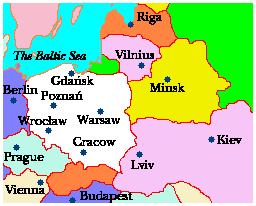
Some details pertaining to the history of particular provinces are accessible by clicking on their names
 |
The map of Central Europe in 1772. The Kingdom of Poland is marked in white; Russia - in green, Austria - in yellow and Prussia - in blue. Present-day political boundaries are shown as red lines. Present names of cities are also given. |
During the second half of the 18th century the Kingdom of Poland was a country which differed from present-day Poland in many important ways. Its territory included all of what we now call Lithuania, Belarus and half of contemporary Ukraine. On the other hand, nearly half of the contemporary area of Poland then belonged to Prussia (or, less precisely - to Germany).
From time immemorial all those territories had been inhabited by diverse peoples of several religions. The western and central regions of the Kingdom were inhabited mostly by Catholics of Polish ethnic background.
Catholic Poles and Lithuanians lived in its north-eastern section, which is now the Republic of Lithuania.
The eastern regions were inhabited by Byzantine Catholics of Ruthenian (which is now Belarussian and Ukrainian) background and a small but important Catholic Polish minority.
All parts of the Polish Kingdom were also inhabited by Jews (about 10% of the whole population) who lived mostly in shtetls, i.e. tiny cities. Also other ethnic groups, e.g. Germans, Armenians, Tartars, Scots, Dutchmen, etc. were represented.
The Prussian provinces of Pomerania,
Silesia
and
East Prussia
which now belong to Poland also had a considerable Polish minority, although
the majority was of German ethnic background. Pomerania and East Prussia
were traditionally Lutheran, whereas most of the Silesian people belonged
to the Roman Catholic Church.
 |
On the left: the map of Central Europe in 1795 (right after the partitions). On the right: the situation after the Vienna Congress in 1815. The autonomous Kingdom of Poland shown in light green. |  |
Between 1772 and 1795 the entire territory of the Kingdom of Poland was divided between Prussia, Austria and Russia. During those so-called Partitions of Poland, Prussia acquired the western regions of Poland, esp. those, which were later renamed to West Prussia (formerly Royal Prussia) and Province of Posen (the area around Poznan, the Polish name being Wielkopolska, i.e. Greater Poland).
The southern Polish territories around Kraków and Lwów were incorporated into the Austrian Empire and renamed Galicia".
The central and eastern provinces of Poland were taken over by the Russian Empire. Only during a short period when Napoleon Bonaparte conquered Central Europe, he restored Poland as a Duchy of Warsaw, dependent on himself, consisting of the territories Prussia and Austria had annexed in 1793-95.
After Napoleon's fall, the situation was finally resolved in 1815. The victorious Russia took control over most of the Duchy of Warsaw. The Tzars gave it relatively much autonomy and created the new Kingdom of Poland there (but dependent on Russia) whereas the former eastern parts of Poland were directly incorporated into the Empire (and the populace of the Byzantine Catholics living there was forced to "convert" to Eastern Orthodox). The boundaries fixed in 1815 were stable during the next century but many other things changed. The 19th century was the time of industrial development and massive migrations. The Polish provinces under Prussian government were slowly germanized as more and more Germans settled there. Several attempts to regain independence were made by Poles, but all the uprisings against Russia, Prussia and Austria were bloodily suppressed. That was one of the reasons why in the last three decades of the 19th century more than a million people emmigrated from Poland, mostly to North America.
The First World War was a catastophe for all the
Empires that had once divided Poland. An independent Republic of Poland
was restored. Most of the 19th century Kingdom of Poland, the whole Galicia
and most of the former Prussian provinces of
West
Prussia and Posen
together with some areas of present-day Belarus, Lithuania and Ukraine
constituted Poland between the Wars. Most German inhabitants of the former
Prussian provinces emigrated to Germany.
 |
On the left: the map of Central Europe in 1920. On the right: in 2000. |  |
As the Second World War began, Poland was attacked by Nazi Germany and the Soviet Union. Both totalitarian countries divided Poland and began to persecute her people.
The Nazis murdered about 90% of the Polish Jews and more than a million of Catholic Poles. The Soviets also murdered a comparable number of Poles, many others experienced to concentration camps in Siberia.
After this horrible period was over and World War II had ended, new boundaries were designed for Central Europe by Stalin, Churchill and Roosevelt at Yalta. Poland lost a third of its pre-WWII area which was taken over by the Soviets. As a "compensation", the allied powers handed over to Poland a large part of Germany east of the Oder and Neisse rivers.
Nearly the entire population of those provinces either escaped the Red Army in 1945 or was later expelled to Germany and the territory was settled by Polish refugees from the East, who wanted to avoid Soviet rule. Also hundreds of thousands of Ukrainians were forced to leave Poland to settle in the Soviet Union. Most of the Jews who survived the Holocaust emigrated to Israel or to the USA.
Because of those migrations, contemporary Poland has practically no population of ethnic minorities - about 5% in total. Except for a few hundred thousand of Germans in Silesia and comparable numbers of Belarussians (in the Easternmost regions) and Ukrainians, all other minorities do not exceed 100,000 people.This is a situation completely different from that throughout the whole of Polish history.